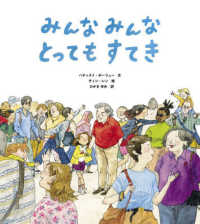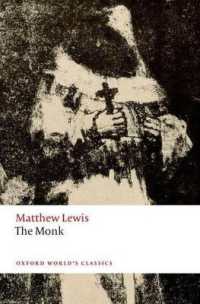- ホーム
- > 洋書
- > 英文書
- > Cinema / Film
Full Description
The first truly interdisciplinary analysis to link Douglas Sirk's striking visual aesthetic to key movements in twentieth century art and architecture, this book reveals how the exaggerated artifice of Sirk's formal style emerged from his detailed understanding of the artistic debates that raged in 1920s Europe and the post-war United States. With detailed case studies of Final Chord and All That Heaven Allows, Victoria Evans demonstrates how Sirk attempted to dissolve the boundaries of cinema by assimilating elements of avant-garde art, architecture and design into the colour, composition and setting of many of his most well-known films. Treating Sirk's oeuvre as a continuum between his German and American periods, Evans argues that his mise-en-scène was the result of an interdisciplinary, transnational dialogue, and illuminates the broader cultural context in which his films appeared by establishing links between archival documents, Modernist manifestos and the philosophical writings of his peers.
Contents
AcknowledgmentsTable of ContentsList of FiguresIntroduction
PART ONE-Sirk and the Visual Arts
Thinking with the Heart: Sirk and Pictorial ReceptionI. From the Haptic and Optic to the Affective and BrechtianII. Going Beyond Melodrama's Visual Metaphors
Concerning the Spiritual in Art: Magnificent Obsession and the Influence of Modernist PaintingI. Some Popular Mid-Century American Responses to Modernist ArtII. Cinema and Painting: Composing other Models
PART TWO-The Shock of the New: Traces of Modernity
The Invasion of Machines and Machine Culture I. Softening the Armoured Heart: Douglas Sirk's The Tarnished AngelsII. Two Conflicting Views of Modern Technology
Imitation of Life and the Depiction of Suburban SpaceI. Some Limitations of the Typical American SuburbII. Stahl Versus Sirk and the Emergence of the Colour Line
PART THREE-Two Architectural Case Studies
Final Chord and "Die Neue Welt": The Mise-en-Scène of AufbruchI. Visions of Modernity: Interpreting the New York SkylineII. The Weight of History: Germany's Imperial MonumentsIII. Determining Final Chord's "New World": The Textual EvidenceIV. Fashion or Revolution: Towards a Non-Bourgeois Interior
Back to the Future: Architecture and All that Heaven AllowsI. Modernism Here and There, Now and Then: Deciphering the Old MillII. The Mill as Architectural Art and the Selling of All That Heaven AllowsIII. Stoningham as Mausoleum: a Repository of Dead ConventionsIV. The Eye of Power: Who is Looking at Whom in the SuburbsV. Et in Arcadia Ego: The Denouement of All That Heaven Allows
Bibliography







